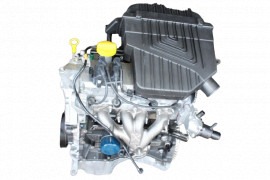Opel Corsa Engine: Top Tips for Upkeep and Treatment
Opel Corsa Engine: Top Tips for Upkeep and Treatment
Blog Article
Exploring the Inner Workings of a Compact Vehicle's Engine System
As motorists, we typically consider provided the intricate procedures that occur within the confines of our lorry's engine system. The compact yet complicated equipment that pushes us ahead is a marvel of design accuracy and control. From the regulated explosions in the combustion chamber to the thorough timing of fuel shot, every element plays an important role in the smooth operation of the engine. In this expedition of a compact car's engine system, we will unwind the internal functions of this mechanical harmony, clarifying the secrets that drive us ahead on our daily trips.
Burning Process Summary
The burning procedure in a small lorry's engine system is a vital system that efficiently transforms gas right into power to power the lorry. This procedure occurs within the combustion chamber of the engine, where fuel and air mix, spark, and generate regulated surges. The combustion procedure contains four main phases: intake, compression, exhaust, and power.
During the intake phase, the piston relocates downward, attracting a mixture of air and gas into the combustion chamber. The following stage, compression, includes the piston relocating up, pressing the air-fuel combination to increase its effectiveness. Consequently, in the power stage, the trigger plug sparks the pressed combination, causing a rapid expansion of gases that forces the piston pull back. This down activity generates the power needed to drive the automobile. Finally, in the exhaust stage, the burnt gases are eliminated from the burning chamber through the exhaust valve, preparing the chamber for the next cycle. This cyclic combustion procedure is essential to the procedure of a small automobile's engine system, ensuring effective energy conversion for propulsion.
Piston and Cylinder Interaction

The piston's exact fit within the cylinder is necessary for keeping optimal compression and stopping power loss during burning. Tight clearances in between the piston and cylinder walls ensure reliable sealing, permitting the piston to move efficiently without permitting gases to leakage past. Correct lubrication is likewise vital to minimize rubbing and wear between these components, improving longevity and efficiency.
Furthermore, the layout and products made use of in producing the piston and cylinder effect engine performance and sturdiness. Modern engines commonly use light-weight yet durable products like light weight aluminum alloys for pistons and cylinder linings to minimize inertia and boost thermal effectiveness. On the whole, the unified communication between the piston and cyndrical tube is essential to the engine's capability and total efficiency.
Fuel Shot System Performance
Fuel shot systems in compact car engines play an essential role in specifically delivering fuel to the combustion chamber for efficient and controlled ignition. The gas shot system operates by injecting fuel into the burning chamber at the optimal moment throughout the engine's procedure (opel corsa engine). This accurate timing guarantees that the fuel blends equally with the air for correct combustion, bring about enhanced gas effectiveness and lowered emissions
There are mainly two sorts of gas injection systems utilized in portable lorry engines: port fuel shot (PFI) and direct gas shot (DFI) PFI systems inject fuel into the intake port before the intake shutoff, while DFI systems inject gas straight into the combustion chamber. Both systems have their advantages, with DFI offering better fuel atomization and PFI offering a more affordable service.
Comprehending Engine Cooling Systems
Reliable operation of a portable automobile's engine depends greatly on the effectiveness of this page its cooling systems. The air conditioning system in a small lorry commonly is composed of a number of elements functioning together to regulate the engine temperature. Comprehending these engine cooling mechanisms is crucial for preserving the performance and durability of a portable lorry's engine system.

Exhaust System Components Explained
The optimal functioning of a compact lorry's engine air conditioning mechanisms depends on a corresponding system referred to as the exhaust system, which consists of various essential components for guaranteeing efficient exhausts and engine performance. The exhaust system includes parts such as the exhaust manifold, catalytic converter, muffler, and tailpipe. look what i found The exhaust manifold gathers exhaust gases from the engine's paths and cylinders them to the catalytic converter. The catalytic converter after that transforms damaging toxins in the exhaust into much less unsafe emissions before releasing them through the muffler and tailpipe.
One crucial component of the exhaust system is the oxygen sensor, which checks the oxygen degrees in the exhaust gases to help regulate fuel consumption and make sure optimal engine performance. opel corsa engine. Furthermore, the resonator may be present in some exhaust systems to reduce noise levels. Generally, the exhaust system plays an essential function in keeping engine efficiency, reducing hazardous exhausts, and making sure a quieter driving experience for compact car owners

Conclusion
In final thought, the small vehicle's engine system is a complex combination of components that work together to help with the burning process, transform fuel right into power, and remove waste gases. Understanding the internal functions of the engine system, consisting of the piston and cyndrical tube interaction, fuel shot system, engine air conditioning next page systems, and exhaust system parts, is critical for keeping ideal performance and performance of the car.
The burning process in a compact car's engine system is an essential device that effectively converts gas into energy to power the vehicle.Gas injection systems in compact automobile engines play a vital role in exactly providing gas to the burning chamber for controlled and effective ignition.There are primarily two types of fuel injection systems used in portable automobile engines: port fuel shot (PFI) and direct fuel injection (DFI) Comprehending these engine cooling mechanisms is essential for keeping the efficiency and durability of a small lorry's engine system.
The optimum functioning of a portable automobile's engine cooling mechanisms depends on a complementary system known as the exhaust system, which makes up numerous essential elements for ensuring efficient emissions and engine efficiency.
Report this page